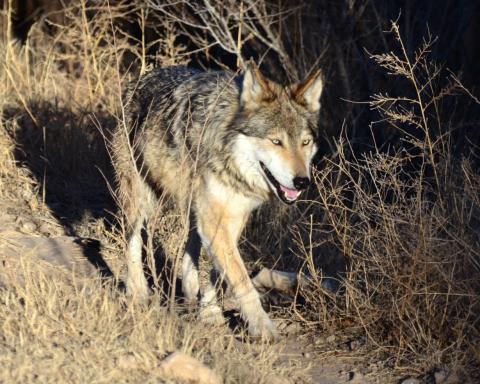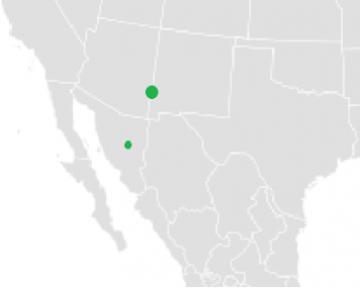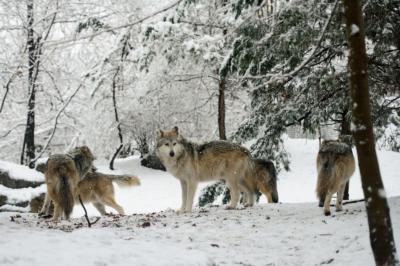|
|
El bobo, Lobo, Mexican grey wolf
|
| LIFE SPAN |
TOP SPEED |
WEIGHT |
HEIGHT |
LENGTH |
| 10-15 YRS |
65 KM/H |
27-36 KG |
66-81 CM |
137-152.4 CM |
A subspecies of the Gray wolf, the Mexican gray wolf is commonly
known as "El lobo". It is gray with light brown colored
fur on its back, and has long legs and a sleek body, which means
it can run fast. Once there were thousands of these wolves but in
the U.S. many had been killed by the mid-1970s, and just a handful
existed in zoos. In 1998, the U.S. Fish and Wildlife Service, under
Jamie Rappaport Clark (who became president of Defenders of Wildlife),
introduced 11 Mexican gray wolves into the wild in Arizona. Their
numbers have grown slowly and they are currently the world’s
most endangered wolf subspecies. These animals can live in captivity
for up to 15 years, but it is suggested that their life span is
rather less in the wild, probably not more than 10 years.
|
No
|
Ca
|
Te
|
Cu
|
Al
|
Pa
|
Pu
|
Ap
|
|
Nocturnal
|
Carnivore
|
Terrestrial
|
Cursorial
|
Altricial
|
Pack hunters
|
Pursuit predator
|
Apex predator
|
|
|
|
Mo
|
So
|
Pa
|
|
|
|
|
|
|
Monogamy
|
Social
|
Pack
|
|
|
|
|
|
|
|
Distribution
Mexican gray wolves were once widespread from central Mexico
through the southwestern U.S. They have now been reintroduced
in southeastern Arizona in the Apache National Forest, and
may move into western New Mexico to the adjacent Gila National
Forest as the population grows. These wolves are also being
reintroduced in Mexico. They prefer habitats of mountain forests,
scrublands and grasslands.
Geography
CONTINENTS North
America
COUNTRIES United
States, Mexico
|
|
Biome
|
Temperate grasslands
|
|
Tropical dry forest
|
|
Shrubland
|
|
Climate zones
|
|
|
Habits and Lifestyle
Mexican gray wolves are a very social species, living in
packs which have complex social structures, including the
alpha male and female, the breeding pair, with their offspring.
The others in the pack are “helpers”. The hierarchy
of dominant and subordinate individuals enables the unit to
work. Wolves usually travel with their pack and establish
a territory that could be 30 square miles up to more than
500. They define their territory with scent markings and vocalizations
such as barks, growls, and their legendary howl. Packs in
regions such as the desert where typically prey is small may
have 7 or fewer members, up to 30 or more where the prey is
large.
|
|
Diet and Nutrition
Mexican gray wolves are carnivores, they eat mule deer, white-tailed
deer and elk, and sometimes smaller mammals such as ground
squirrels, rabbits and mice.
DIET Carnivore
|
| Mating Habits |
| MATING BEHAVIOR |
Monogamy
|
| REPRODUCTION SEASON |
mid-February-mid-March |
| PREGNANCY DURATION |
63 days |
| BABY CARRYING |
4-7 pups |
| INDEPENDENT AGE |
5 weeks |
| FEMALE NAME |
bitch |
| MALE NAME |
dog |
| BABY NAME |
pup, whelp |
|
Mexican wolves are monogamous, with only
the pack’s alpha pair breeding each year. The season
for mating is from mid-February to mid-March and gestation
lasts about 63 days. Litters number 4 to 7 pups, which
are born blind. They are reared inside a den which is
a burrow or natural hole. Every member of the pack cares
for the pups, feeding them regurgitated meat after hunts.
They are weaned in about the fifth week, approaching adult
size early in winter. By autumn, when the pups are able
to travel with the adults, a pack will hunt throughout
its territory as a unit. Juveniles stay with the pack
for about two years, when they reach reproductive maturity,
and may leave to find a mate and establish a new territory,
or remain as a helper. |
|
|
|
Population
Population threats
Humans are the biggest threat to this species. Mexican gray
wolves were common about 100 years ago, but then many wolves
were killed due to competition for the same resources with
humans. In the late 1800's, once railroads were built, large
numbers of settlers moved to the southwest. There was no protection
at that time for wildlife. Many of the prey animals for this
species were killed, and wolves were trapped, poisoned, or
shot to protect people's livestock. Many wolves were also
killed because fables (such as "Little Red Riding Hood")
portray wolves as ferocious killers, or cunning tricksters,
which does not reflect the true behavior of wolves.
|
|
Population number
According to the U.S. Fish and Wildlife Service, the total
population size of the Mexican wolf in 2015 was 97 individuals
in the wild. This includes 50 wolves in Arizona, 47 wolves
in New Mexico and 7 breeding pairs in total. About 300 wolves
in 48 different facilities live in the U.S. and Mexico. Mexican
gray wolves are listed as Endangered by the Endangered Species
Act (ESA) (NMFS NOAA Fisheries).
|
| Fun Facts for Kids |
|
Mexican gray wolves are the smallest of the
Gray wolf subspecies, being around half the size of North
American gray wolves.
The Mexican gray wolf is the world’s
most endangered wolf.
The fur of Mexican gray wolves is a mixture
of gray, black, rust, and cream.
Mexican gray wolves wag their tails, howl,
yip, growl, play, and mark their territory with urine.
Mexican gray wolves usually eat only twice
a week, and eat as much as 20 pounds of meat in one go.
Wolves do not sleep cuddled up with each other
in wolf dens, as many believe. In fact, they sleep in the
open, whatever the weather. They establish their sleeping
area by circling it before lying down.
|
|







